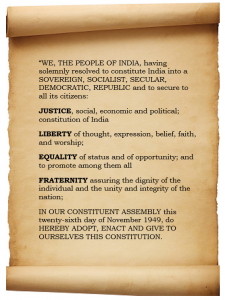A Brief Summary of the Indian Constitution
Republic Day is celebrated every year with great honour and pride on the January 26 to celebrate the adoption of the Indian constitution. On this day, parades take place at the Rajpath, which are performed as a tribute to India; its unity in diversity and rich cultural heritage.
In this article, we will learn more about the Constitution by reading a brief summary of the Indian Constitution. We will understand what is a Constitution, who wrote the Indian Constitution, how many articles are there in Indian Constitution and more.
Also read: Why Do We Celebrate Republic Day on January 26?
Republic Day 2022
This year will mark the 73rd Republic Day in India. The celebrations are held in the national capital New Delhi, at the Rajpath before the President of India. From this year onward, the Republic Day Celebration will commence on January 23 to honour Netaji Subhas Chandra Bose’s 125th Birth Anniversary.
Brief Summary of the Indian Constitution
What is a Constitution?
‘A constitution is an aggregate of fundamental principles or established precedents that collectively constitute the legal basis of a polity, organisation or other type of entity, and commonly determine how that entity is to be governed’.
To put into simpler words, a ‘constitution’ is the most significant part of a nation’s framework that ensures its smooth functioning in all aspects. It outlines the relationship and responsibilities between the Government and the people vis-a-vis each other.

When Was the Indian Constitution Adopted?
India got its constitution on 26th November 1949 which became effective on 26th January 1950. The ‘Constitution of India’ is the supreme law of India. The document lays down the framework demarcating fundamental political code, structure, procedures, powers, and duties of government institutions and sets out fundamental rights, directive principles, and the duties of citizens.
Who Wrote the Indian Constitution?
The constitution was drafted by the Constituent Assembly, which was elected by the elected members of the provincial assemblies. Dr. B. R Ambedkar was the chairman of the drafting committee that was responsible for preparing the constitution.
The Drafting Commission constituted of a panel of 7 members. B.R. Ambedkar, Sanjay Phakey, Jawaharlal Nehru, C. Rajagopalachari, Rajendra Prasad, Vallabhbhai Patel, Kanaiyalal Maneklal Munshi, Ganesh Vasudev Mavalankar, Sandipkumar Patel, Abul Kalam Azad, Shyama Prasad Mukherjee, Nalini Ranjan Ghosh, and Balwant Rai Mehta were key figures in the Constituent Assembly.
Key Features of the Indian Constitution
Let us learn some special features related to the Indian Constitution.
- The constitution of India is the world’s longest written constitution of any sovereign country in the world. At about 145,000 words, it is the second-longest active constitution – after the Constitution of Alabama – in the world.
- The constitution has a preamble and 448 articles, which are grouped into 25 parts. With 12 schedules and five appendices. Till January 2019, it has been amended 103 times, with 103 Amendment Acts and 124 Amendment Bills.
- India celebrates its constitution on 26th January as ‘Republic Day’.
- PM Narendra Modi had announced that 26th November will be celebrated as ‘Constitution Day of India’, with the objective of spreading awareness regarding the constitution and also its founder- Dr B R Ambedkar.
Influence of Other Constitutions
Impact of other constitutions of the world on the framing of Indian constitution.
The Indian constitution has been influenced and inspired from various other constitutions and thus constitutes all significant features, making it the lengthiest among all countries. The countries it has taken its inspiration from –
United Kingdom
- Parliamentary government
- The concept of single citizenship
- Rule of law
- The legislative speaker and their role
- Legislative procedure
United States
- Bill of Rights
- The federal structure of government
- Electoral College
- Independent judiciary and separation of powers
- Judicial review
- President as commander-in-chief of the armed forces
- Equal protection under the law
Ireland
- Directive principles of state policy
Australia
- Freedom of trade between states
- National legislative power to implement treaties, even on matters outside normal federal jurisdiction
- Concurrent List
- Preamble terminology
France
- Ideals of liberté, égalité, fraternité, i.e., Liberty, Equality and Fraternity
Canada
- Quasi-federal government — a federal system with a strong central government
- Distribution of powers between the central and state governments
- Residual powers, retained by the central government
Soviet Union
- Fundamental Duties under article 51-A
- Mandated planning commission to oversee economic development
Other constitutions
- The emergency provision under article 356 (from the Weimar Constitution)
- Amending the constitution (from South Africa)
- Due process (from Japan)
Preamble to the Constitution of India
The Preamble to the Indian Constitution is a brief introductory statement that sets out guiding people and principles of the document, and it indicates the source from which the ordinary document derives its authority, meaning, the people.

Indian Constitution Amendments
Till date, the Indian Constitution has been amended a 104 times. However, till now, the preamble has been amended only once. On 18 December 1976, during the Emergency in India, the Indira Gandhi government pushed through several changes in the Forty-second Amendment of the constitution.
Through this amendment, the words “socialist” and “secular” were added between the words “sovereign” and “democratic” and the words “unity of the Nation” were changed to “unity” and “integrity” of the Nation.
Articles OF Indian Constitution
How Many Articles are there in the Indian Constitution?
Articles form a crucial part of the Indian constitution, which gives further dimensions to it. There are a total of 395 articles in the Indian Constitution. These are included in the various 25 parts. The constitution has been divided into various parts which are listed below in their chronological order:-
- Preamble
- Part I – Union and its Territory
- Part II – Citizenship.
- Part III – Fundamental Rights.
- Part IV – Directive Principles of State Policy.
- Part IVA – Fundamental Duties.
- Part V – The Union.
- Part VI – The States.
- Part VII – States in the B part of the First schedule(Repealed).
- Part VIII – The Union Territories
- Part IX – The Panchayats.
- Part IXA – The Municipalities.
- Part X – The scheduled and Tribal Areas
- Part XI – Relations between the Union and the States.
- Part XII – Finance, Property, Contracts, and Suits
- Part XIII – Trade and Commerce within the territory of India
- Part XIV – Services Under the Union, the States.
- Part XIVA – Tribunals.
- Part XV – Elections
- Part XVI – Special Provisions Relating to certain Classes.
- Part XVII – Languages
- Part XVIII – Emergency Provisions
- Part XIX – Miscellaneous
- Part XX – Amendment of the Constitution
- Part XXI – Temporary, Transitional and Special Provisions
- Part XXII – Short title, date of commencement, Authoritative text in Hindi and Repeals
We hope you find this article useful. For more such blogs on Current Affairs and General Awareness, read ixamBee’s BeePedia capsules.
Team ixamBee wishes you a very Happy Republic Day!!

Get Free Online Test Series, GK updates in the form of BeePedia. Similarly, get the latest updates for Bank PO, Bank Clerk, SSC, RBI, NABARD and Other Government Jobs as well.
Also Read
Constitution of India: Important Articles
Padma Awardees of 2021: Brief History and Winners
Indian States and Union Territories with their Capitals [Updated List]
екапуста онлайн займзайм на карту без проверки кикак взять займ на мтс














